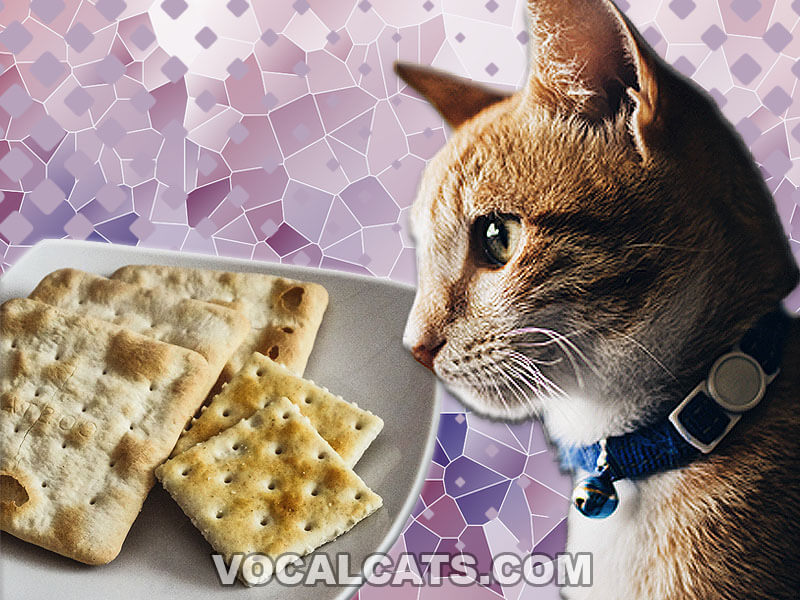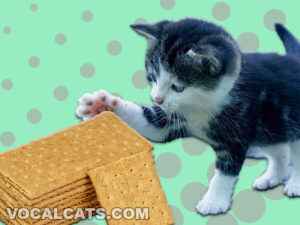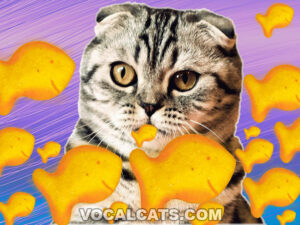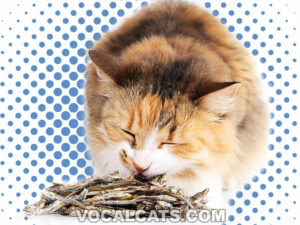Can cats eat Saltine Crackers? No, cats should not eat Saltine Crackers because they are high in sodium, fats, carbohydrates, and calories. As obligate carnivores, cats should have minimum carbs and sodium in their diet. If your cat consumes Saltine Crackers regularly or in large amounts, he can eventually suffer from long-term health issues like feline-obesity, diabetes, digestive issues, dehydration, or salt poisoning.
If you’re eating some Saltine Crackers and your feline friends are begging you for some, you’re probably wondering, “Can my cat eat Saltine Crackers?” Would your kitties be okay after munching on a Saltine Cracker? The simple answer is no. Instead of handing your fuzzy friend a human snack full of salts and carbs, he simply needs a high-protein diet that can benefit his overall health.
Saltine Crackers share many of the same ingredients as Graham Crackers, including salt, unbleached enriched flour, and yeast, so it’s no surprise if your furry friends experience many of the same negative health effects such as lethargy, vomiting or diarrhea. All three of these ingredients are harmful to your cat. Keep reading as we’ll discuss this later in detail.
Contents
- Can cats have Saltine Crackers?
- Health risk of Saltine Crackers on cats
- Do Saltine Crackers provide any nutritional benefits for your cat?
- What if my cat accidentally ate Saltine Crackers? What will happen? What should I do?
- Symptoms to watch for
- Treatments if your cat has food poisoning from Saltine Crackers
- What are some feline friendly and safe non toxic Saltines alternatives?
- So, can cats eat Saltine Crackers?
- Related Questions
Can cats have Saltine Crackers?
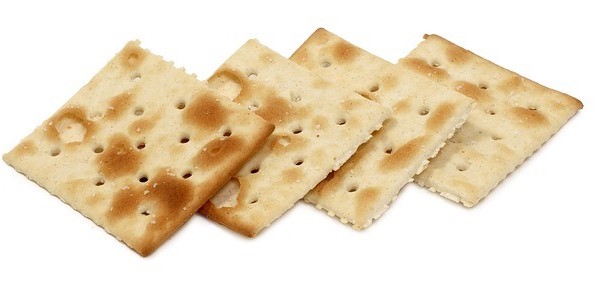
No, cats should not have Saltine Crackers because this human snack was not made for feline consumption. Saltine Crackers don’t provide any nutritional value to your cat and are considered filler food.
If you keep feeding your feline friends Saltine Crackers, please note that they will neither reject nor decline your offer. That’s because our cats are intrigued by the taste of this crunchy snack and will keep eating it as long as you keep feeding them this snack.
It’s worth noting that cats aren’t able to produce certain nutrients like Taurine and Arginine in their bodies. These are two amino acids are present in animal meat and they help to build protein, which our four-legged friends need.
Cats thrive on animal meat and receive their their nutrition and energy specifically from that. If their diet lacks enough protein, such as Taurine, they can develop heart and eye problems.
Cat owners that fail to provide their feline family members with essential nutrients or do not research the food before feeding their kitties may put their little fur balls at risk of getting sick, gaining unnecessary weight, or having diabetes.
Also, it’s not fun to receive an unexpected high medical bills.
RECOMMENDED: Can Cats Eat Animal Crackers?
What are Saltine Crackers?
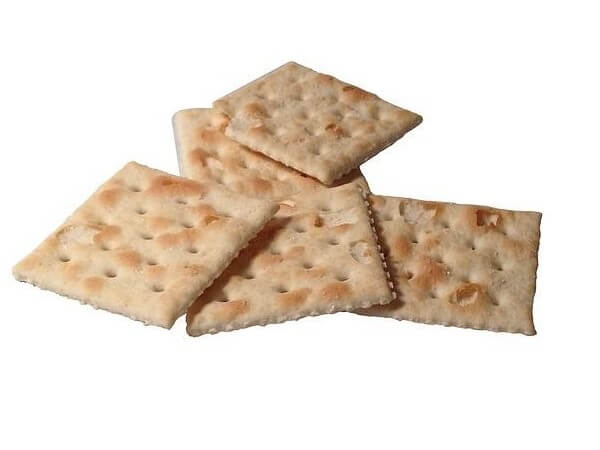
Saltine Crackers have been around since the 1980s and were based on a type of bread that sailors would take with them to sea. This was a dense bread known as hardtack or pilot bread.
Unlike traditional bread, pilot bread would not go bad and would remain ready to consume even in the moist sea air.
Later on, Saltine Crackers were invented during the Great Depression when people used them to add texture to soups or meatball mixtures.
Also known as soda crackers or saltina, Saltine Crackers are a popular snack that contains unbleached enriched flour, a leavening agent like yeast or baking soda, palm oil, canola oil, and salt.
They are square-shaped, thin, and crispy, with docking holes on the surfaces to create wafer-thin structure during baking. Most Saltine Crackers are plain with just the docking holes on the top surfaces. Some Saltine Crackers have sea salt or coarse salt added for a more saltier taste.
Saltine Crackers can be consumed on their own as a snack or served with cheese, soups, stews, or used as topping for baked casseroles.
What are Saltine Crackers made of?
Saltine Crackers are made from flour (unbleached enriched flour and malted barley flour), as well as salt, leavening (baking soda and yeast), canola oil, and palm oil. The complete list of ingredients, along with the negative health effects these can have on your fuzzy friends, are given below.
Saltine Crackers ingredients
⦁ Unbleached enriched flour includes wheat flour, niacin, reduced iron, thiamine mononitrate (Vitamin B1) riboflavin (Vitamin B2), and folic acid.
⦁ Canola oil.
⦁ Palm oil.
⦁ Sea salt.
⦁ Salt.
⦁ Malted barley flour.
⦁ Baking soda.
⦁ Yeast.
Health risk of Saltine Crackers on cats
Almost all of the ingredients in Saltine Crackers poses a health risk for cats.
The salt can lead to sodium poisoning and water retention.
Too many carbs can cause sudden spikes in glucose levels that level off after a short while, so your cat is hungry again. This leads to unnecessary weight gain as your cat is eating more often than before. Overtime, weight gain can lead to feline obesity.
Additionally, yeast used in Saltine Crackers can cause bloating and alcohol poisoning.
Below, we will discuss the effects of each ingredient on your cat’s health.
Unbleached enriched flour can lead to feline obesity
Unbleached enriched flour is a highly processed flour that is off-white in color because it lacks the bleaching agent usually added to bleached flour to speed up its aging process.
During the milling process, both the bran and the germ (the nutrient powerhouse in wheat) are removed from the wheat kernel so only the endosperm is left. As a result of this process, the flour is stripped of its essential nutrients that would’ve made it beneficial.
However, later in the processing stage, some nutrients are added back into the flour, making it ‘enriched.’ These nutrients and minerals include niacin, thiamine, folic acid, riboflavin, and iron.
Having said that, even these nutrients don’t outweigh the number of carbs in this flour. The high carb in unbleached enriched flour and ultimately in Saltine Crackers are why they are harmful for feline consumption.
As we can see from the ingredient list above, unbleached enriched flour is the first item listed. This means that the Saltine Crackers are mostly made of unbleached enriched flour.
In fact, more than half of a Saltine Cracker contains unbleached enriched flour, which is just carbs. Just one Saltine Cracker has 2.4 grams carbohydrates. Carbohydrates have a high glycemic index, meaning they rapidly release glucose in the blood. This triggers insulin production that absorbs extra glucose leading to a severe drop in energy, making your cat hungry again. If your cat keeps eating at such a rate, he will begin to become overweight and eventually obese.
One serving of unbleached enriched flour contains 22 grams of total carbs, while only a meager 4 gram of protein. Moreover, it has 110 calories, which is too much for cats and their bodies store it as fat.
Additionally, if your kittens are allergic to wheat or gluten, avoid feeding them food that contains unbleached enriched flour.
A balanced diet for a cat should include only 10% or fewer carbs, while the rest of it should be animal based protein and around 30% to 40% fat. This is because cats lack the amylase enzyme to properly digest carbohydrates. Our kitties only have small amounts of the amylase enzyme in their pancreas, intestines, and saliva. Consuming too many carbs can cause vomiting, diarrhea, and lethargy in cats.
Canola oil
Made from rapeseed plant, canola oil is a vegetable oil that contains a lot of mono-unsaturated fatty acids, a little saturated fat, and plant sterols that help lower cholesterol levels in humans. However, this oil can severely affect our feline friends’ health, especially if they consume lots of it.
In just 100 grams of canola oil, there are 28.1 grams of polyunsaturated fat, which is considered ‘bad’ fat. Bad fats are pro-inflammatory and don’t have any essential health benefits for our feline friends.
According to Dr. Jeannie Thomason, a veterinary naturopath and a writer, when canola oil is consumed, it mixes with blood and forms a ‘latex-like’ substance that causes anemia, respiratory problems, constipation, blindness, and damages the nervous system. She says rapeseed is toxic, and even insects don’t go near it.
Other health problems your kittens can suffer from after ingesting canola oil include lung cancer, fibrotic heart lesions, and vitamin E deficiency. To stay safe and prevent health risks, moderation is key.
Palm oil
Another oil used to make Saltine Crackers is palm oil, which is high in saturated fat. This vegetable oil is produced from the pulp of palm tree fruits. We use it worldwide in cleaning products, cosmetics, and processed food.
When consumed, it also produces a laxative effect, like canola oil, that can cause diarrhea, vomiting, pancreatitis, or dehydration in cats.
Although palm oil does contain beta-carotene, our feline family members cannot efficiently convert beta-carotene into vitamin A like other animals can.
In general, when an animal ingests palm oil, the beta-carotene is absorbed in the intestines and carried to the liver. This is where it’s combined with fats to form vitamin A. However, since cats can’t successfully convert the beta-carotene found in palm oil into vitamin A, it’s useless for cats to consume palm oil.
For these reasons, palm oil serves little to no health benefit to cats. Instead of Saltine Crackers, our feline companions should receive their vitamin A intake from meat and not from salty human snacks.
High salt level can lead to sodium poisoning in cats
Sea salt is just table salt that is impure and not processed. It is a bit like rock salt as it has a lot of minerals that table salt doesn’t have. Allowing your four-legged friends to consume human snack, like Saltine Crackers, that contains high salt levels is not a good idea.
Our furry friends do not need salt in their food for taste and they should receive their daily salt intake from their regular feline food.
A cat should only ingest 20 to 40 mg of salt daily. Even a teaspoon of salt can become too much for cats leading to electrolyte imbalance in cats and eventually sodium poisoning or hypernatremia.
Signs and symptoms of salt poisoning in cats include:
- Vomiting.
- Diarrhea.
- Lethargy.
- Seizures (in severe cases).
- Incoordination.
- Excessive thirst.
- Tremors.
- Coma (in severe cases).
- Feline obesity.
A little salt, such as a pinch, won’t harm your cat, but venturing out of the safe zone can majorly affect your cat’s health.
SEE ALSO: Can Cats Eat Goldfish Crackers?
Malted barley flour
Malted barley flour contains tannins which are polyphenols usually present in plant foods. They are bad for cats because they can decrease your cats’ growth rate and reduce protein digestibility. As a result, it can harm a cat’s digestive system by causing diarrhea and vomiting.
Malted barley flour also contains gluten. If your furry friends have wheat allergy or are sensitive to gluten, you’ll want to avoid feeding them any food or snacks that contain malted barley flour.
Baking soda
Consuming a large amount of baking soda can mess up your cat’s electrolyte balance. It can decrease the amount of calcium and potassium found in your furry friend’s body while increasing sodium level. This results in diarrhea, dehydration, disorientation, and shortness of breath in cats.
Cats should also consume baking soda in moderation, just like salt. You should limit your cat’s baking soda intake to just one teaspoon per pound of their body weight.
Yeast
Consuming uncooked yeast is very dangerous for your furry family member. After the yeast settles into your cat’s stomach, it will continue to rise and expand. This can lead to bloating, and your cat might even require surgery to get rid of the dough.
Also, after yeast ferments, it produces ethanol, a form of alcohol. After alcohol absorbs into your cat’s bloodstream, it can cause alcohol poisoning in felines.
Do Saltine Crackers provide any nutritional benefits for your cat?
No, Saltine Crackers do not provide any nutritional benefits for cats. Cats need a lot of animal-based protein in their diet and Saltine Crackers do not offer any protein that they need.
Saltine Crackers also contain many harmful ingredients to our feline family members, resulting in severe health issues like vomiting, diarrhea, lethargy, disorientation, sodium poisoning, and even alcohol poisoning.
Next, let’s see what kind of nutrients one Saltine Cracker contains for clarity.
Nutritional value of Saltine Crackers
Nabisco Saltine Crackers Nutrition Facts (1 Saltine Cracker or 3.2 grams)
| Name, Unit | Amount |
| Calories, cal | 14 |
| Total Fat, g | 0.4 |
| Sodium, mg | 27 |
| Total Carbohydrate, g | 2.4 |
| Protein, g | 0.2 |
| Calcium, mg | 1 |
| Potassium, mg | 5 |
As we can see from the nutritional profile of Saltine Crackers above, one Saltine Cracker weighs around 3.2 grams and contains 14 calories and 2.4 grams of carbohydrates. A cat should consume about 24 to 35 calories per day per pound.
An average-sized cat weighs around 10 pounds, meaning he should only consume about 240 calories daily. Saltine Crackers seem to provide more calories and less nutritional benefits for a cat that should have most of its diet based on animal protein.
There’s also a lot of sodium in one Saltine Cracker. There is 27 mg of sodium, as compared to calcium (1 mg ) and potassium (5 mg). Too much sodium can put your feline friends at risk of sodium poisoning and can even lead to feline obesity.
What if my cat accidentally ate Saltine Crackers? What will happen? What should I do?
As mentioned above, one Saltine Cracker doesn’t contain enough ingredients to harm your cat. However, if you notice your entire pack of Saltine Crackers is empty or missing, it is best to monitor your kitties closely for the next 12 to 24 hours and watch for any signs of behavioral changes or abnormality.
If you’re sure your cat was the one that finished your pack of Saltine Crackers, contact your vet immediately. Your vet may ask you to bring your cat to the veterinary hospital for a physical and health examination. At the cat hospital, the vet will look for signs of sodium poisoning and treat accordingly.
Symptoms to watch for
Your cat would show signs of illness if he had one too many of your Saltine Crackers. Try to observe your cat around the clock for these symptoms:
- Vomiting.
- Lethargy.
- Diarrhea.
- Disorientation.
- Incoordination.
- Dehydration.
- Loss of appetite.
- Tremors.
Treatments if your cat has food poisoning from Saltine Crackers
Your kitty cats could suffer from sodium poisoning if they had too many Saltine Crackers. Check for any of the symptoms above. If you notice any of them, rush your cat to a nearby veterinary hospital so the vet can identify the issue and give your cat the required medical care.
You can expect your vet to monitor your little fur balls for a while to check their electrolyte levels and ensure they return to normal. Cats will usually recover quickly after the vet provides them with constant supply of fresh water and inducing vomiting to get rid of the Saltine Crackers from the cat’s stomach.
Be sure to only allow your vet to induce vomiting. It’s not a good idea to induce vomiting yourself, especially if you’ve never done this before.
What are some feline friendly and safe non toxic Saltines alternatives?
As obligate carnivores, cats prefer animal-based protein and get almost all of their energy from that. For this reason, try to incorporate as much protein into your cat’s diet as possible. This can be cooked or boiled chicken or beef. You can also feed fish to your cat, such as canned tuna. They keep your feline friends’ heart strong while maintaining their sharp vision.
You can also buy high-quality cat food, such as Royal Canin Cat Food. It is a well-known French company that sells cat food for different age groups of cats.
So, can cats eat Saltine Crackers?
So, can your cat have a Saltine Cracker? A nibble or two won’t harm your feline friends, but if the quantity increases, it can affect your fuzzy friend’s health in numerous ways.
From digestive issues to obesity and diabetes, the list of health issues keep getting worse.
To prevent this from happening, feed your kitties a well-balanced and nutritious diet that is high in protein. You’ll also want to keep your Saltine Crackers high up in a cupboard where your furry family member won’t be able to reach.
Related Questions
Your cat can suffer from sodium poisoning as well as other health issues such as vomiting, diarrhea, tremors, seizures, lethargy, incoordination, and even coma. Saltine Crackers are human snacks that contain low nutritional value. Due to this, your feline family members won’t be getting the proper nutrition and energy they requires daily.
Yes, if your cats eat a lot of Crackers, they can get sick. The high salt content in Crackers is toxic to cats if it exceeds 40 mg daily. In addition, your little fur baby won’t be able to digest carbs, which can cause vomiting and other digestive issues.
If your cat has only nibbled on a small piece of the Saltine Cracker, he should be fine. However, if the entire box of Saltine Crackers is empty, then you should take her to a vet as soon as possible. During the trip to the vet, you’ll want to observe him for any of the symptoms we’ve mentioned above in the article. If he shows any of the above signs or symptoms, your vet will perform the necessary medical treatment and guide you on the next steps.
DISCLAIMER: THIS WEBSITE DOES NOT PROVIDE MEDICAL ADVICE
The information, including but not limited to, text, graphics, images and other material contained on this website are for informational purposes only. No material on this site is intended to be a substitute for professional veterinary advice, diagnosis, or treatment. Always seek the advice of your veterinarian or other qualified health care provider with any questions you may have regarding dietary needs.
Resources:
https://en.wikipedia.org/wiki/Saltine_cracker
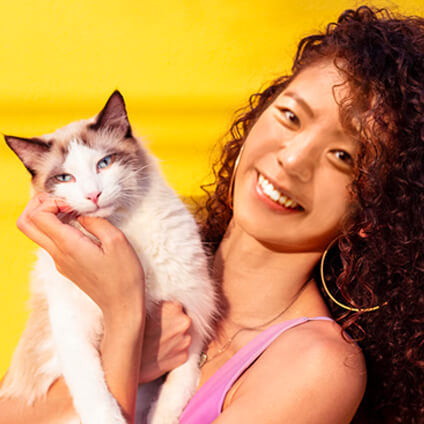
With over five years of specialized experience as an animal writer, my expertise lies in cat nutrition, health, behavior, grooming, and training. I am dedicated to delivering helpful and informative content that caters to the well-being of our feline friends. My primary goal is to empower pet owners with knowledge and ensure our feline companions thrive in health and happiness. In my free time, I love volunteering at local cat rescue centers.
